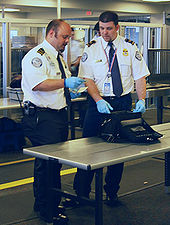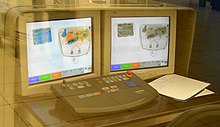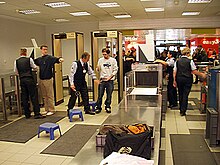Security control
A security check is a check of people in different places, for example in museums , authorities and events. Here, authorized personnel intervene in individual personal rights. In the commercial aviation and a few high-speed links in the railway are in airports and railway stations passengers and the carried them baggage to security-related items in a portal controlled before entering the aircraft arrive, the train or in a safety area.

target
The security check serves the security of the property, its facilities and its staff. In air traffic, airport and aviation security is monitored by monitoring items carried for prohibited items such as weapons and explosives . It is used to protect against criminal acts directed against the aircraft , the crew or other passengers. Primary goal is the prevention of crimes such as hijackings or explosion crime (eg., By luggage bombs or suicide attacks ).
Aviation security controls
In aviation security , there are two types of security checks: one is the control of people, the other of the control of goods such as luggage and cargo . There are often multiple controls on flights with companies or to countries that could pose a particular risk. In many countries around the world, passengers are also checked on national flights, at least in scheduled services, but less often in individual traffic.
Person control for entering the security areas on the air side
Security checks at airports are particularly intensive for air travelers . In air traffic , people are referred to as passenger control ( FGK ), which also includes other personnel who want to enter the security area (e.g. cabin , cleaning staff , sales staff in duty-free shops) and personnel and goods control ( PWK ). Basis for FGK u. In Germany, PWK is Section 5 and Section 8 of the Aviation Security Act . Extremely precise checks are carried out on flights to and from Israel and the United States.
Only after the check can the passenger enter the security area with his hand luggage and get to boarding and the main luggage can be loaded onto the aircraft. At some airports, each checked bag is given a strip-shaped sticker with the words Checked baggage or similar. These are dated or change their color irregularly. There are also locking seals at many German airports (see illustration).
Passengers and hold luggage

The security check here includes, among other things, a search of passengers and hand luggage. Nowadays luggage is mostly examined with technical devices (e.g. X-rays and metal detectors ). Since the attempted bomb attacks on 10 August 2006 at London Heathrow Airport with liquid explosives, liquids have only been allowed to a limited extent in the EU (one transparent bag per person with a maximum capacity of one liter, in it only liquid containers with a maximum capacity of 100 ml). The reason for this is that explosive liquids cannot be detected during routine checks. Bringing explosive and flammable objects and sharp objects such as nail scissors, pocket knives and travel knives in hand luggage has long been prohibited in the ICAO contracting states. Computer tomographs are being used more and more to scan luggage. By the end of 2022, the federal police want to procure 89 devices at a unit price of around 2.3 million euros.
The passengers bring all loose items such as hand luggage, photo bags , sometimes belts, etc. onto a small conveyor belt that transports the items to a screening unit. The monitors are viewed by trained personnel and the luggage is checked via the system. In case of doubt, the bag will be opened and searched. Meanwhile, the passengers pass through a gate equipped with metal detectors. When an acoustic signal sounds, those affected are physically searched. In industrialized nations, except in Italy, this is the same sex.
"Whole body scanner"
A controversial type of security check of passengers is the body scanner , which is already used in some airports. In this imaging process, the clothing of the passengers is "x-rayed" with electromagnetic radiation (for example terahertz technology), ie the staff can see details down to the bare skin (in false colors).
From 2010, according to the plans of the EU Transport Commissioner Antonio Tajani and the will of the EU Commission, passengers should be "video" screened at the gate entrances to their skin. The Federal Data Protection Commissioner and the Police Union (federal executive committee) have criticized this proposal, as this process would strongly interfere with the constitutionally protected personal rights . There were also concerns about the liberal spectrum in the European Parliament as well as from Bündnis 90 / Die Grünen (federal executive) and the SPD federal executive. At Schiphol Airport (Amsterdam) and at some American airports, the technology is already used in accordance with national law and is mandatory. However, the EU proposal is voluntary. After evaluating a ten-month test phase with the participation of 809,000 voluntary passengers, Federal Interior Minister Hans-Peter Friedrich decided at the end of August 2011 not to use body scanners at German airports for the time being.
Main baggage
The main baggage is usually not checked in the presence of the passenger; when traveling to some destination countries, it is locked with a padlock or the like. not permitted so that the luggage can be opened by security personnel (see also TSA lock ). The passenger only receives the luggage again after the flight has ended. Especially in the 1970s and 1980s, when routine checks of checked baggage were not yet common, but at the same time the risk of attacks by extremist groups was relatively high, it was common on flights at risk for passengers to identify their baggage immediately before boarding had to. The appearance of suicide bombers made this security concept obsolete and led to ever more intensive controls. Nowadays, therefore, in addition to computed tomography methods, methods of scattered X-ray imaging are increasingly used to detect hazardous substances.
Performers
Executives are either employees of private companies on behalf of the airport operator or the air traffic control or employees of the authorities or agents of the organizers.
See also
- Body search
- Secondary Security Screening Selection (USA)
- Piercings at security checkpoints
- Police control
Web links
Footnotes
- ↑ Martin U. Müller : Security checks at the airport: Are the restrictions on liquids falling? In: Spiegel Online . December 20, 2019 ( spiegel.de [accessed January 7, 2020]).
- ↑ Minister of Justice attaches conditions to the use of naked scanners . In: heise.de . January 7, 2010. Retrieved August 11, 2019.
- ↑ Air traffic: Protests against naked scanners at airports , Focus , October 23, 2008
- ^ "Peepshow" at the airport: EU plans nude scanner , Abendzeitung , October 23, 2008
- ↑ EU Commission wants to screen passengers , Deutsche Welle , October 24, 2008
- ↑ Naked scanners fail in practical tests , Spiegel Online, August 31, 2011
- ↑ XRD 3500 . In: Safran Identity & Security . February 11, 2015 ( morpho.com [accessed February 23, 2017]).
- ↑ K. Wells, DA Bradley: A review of X-ray explosives detection techniques for checked baggage . doi : 10.1016 / j.apradiso.2012.01.011 .

